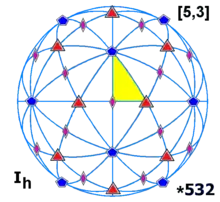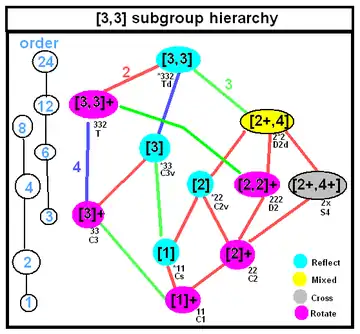 Involutional symmetry Cs, (*) [ ] = |
 Cyclic symmetry Cnv, (*nn) [n] = |
 Dihedral symmetry Dnh, (*n22) [n,2] = | |
| Polyhedral group, [n,3], (*n32) | |||
|---|---|---|---|
 Tetrahedral symmetry Td, (*332) [3,3] = |
 Octahedral symmetry Oh, (*432) [4,3] = |
 Icosahedral symmetry Ih, (*532) [5,3] = | |

A regular tetrahedron has 12 rotational (or orientation-preserving) symmetries, and a symmetry order of 24 including transformations that combine a reflection and a rotation.
The group of all (not necessarily orientation preserving) symmetries is isomorphic to the group S4, the symmetric group of permutations of four objects, since there is exactly one such symmetry for each permutation of the vertices of the tetrahedron. The set of orientation-preserving symmetries forms a group referred to as the alternating subgroup A4 of S4.
Details
Chiral and full (or achiral tetrahedral symmetry and pyritohedral symmetry) are discrete point symmetries (or equivalently, symmetries on the sphere). They are among the crystallographic point groups of the cubic crystal system.
| C3 | C3 | C2 |
| 2 | 2 | 3 |
Seen in stereographic projection the edges of the tetrakis hexahedron form 6 circles (or centrally radial lines) in the plane. Each of these 6 circles represent a mirror line in tetrahedral symmetry. The intersection of these circles meet at order 2 and 3 gyration points.
| Orthogonal | Stereographic projections | ||
|---|---|---|---|
| 4-fold | 3-fold | 2-fold | |
| Chiral tetrahedral symmetry, T, (332), [3,3]+ = [1+,4,3+], | |||
 |
 |
 |
 |
| Pyritohedral symmetry, Th, (3*2), [4,3+], | |||
 |
 |
 |
 |
| Achiral tetrahedral symmetry, Td, (*332), [3,3] = [1+4,3], | |||
 |
 |
 |
 |
Chiral tetrahedral symmetry
 The tetrahedral rotation group T with fundamental domain; for the triakis tetrahedron, see below, the latter is one full face |
 A tetrahedron can be placed in 12 distinct positions by rotation alone. These are illustrated above in the cycle graph format, along with the 180° edge (blue arrows) and 120° vertex (reddish arrows) rotations that permute the tetrahedron through those positions. |
 In the tetrakis hexahedron one full face is a fundamental domain; other solids with the same symmetry can be obtained by adjusting the orientation of the faces, e.g. flattening selected subsets of faces to combine each subset into one face, or replacing each face by multiple faces, or a curved surface. |
T, 332, [3,3]+, or 23, of order 12 – chiral or rotational tetrahedral symmetry. There are three orthogonal 2-fold rotation axes, like chiral dihedral symmetry D2 or 222, with in addition four 3-fold axes, centered between the three orthogonal directions. This group is isomorphic to A4, the alternating group on 4 elements; in fact it is the group of even permutations of the four 3-fold axes: e, (123), (132), (124), (142), (134), (143), (234), (243), (12)(34), (13)(24), (14)(23).
The conjugacy classes of T are:
- identity
- 4 × rotation by 120° clockwise (seen from a vertex): (234), (143), (412), (321)
- 4 × rotation by 120° counterclockwise (ditto)
- 3 × rotation by 180°
The rotations by 180°, together with the identity, form a normal subgroup of type Dih2, with quotient group of type Z3. The three elements of the latter are the identity, "clockwise rotation", and "anti-clockwise rotation", corresponding to permutations of the three orthogonal 2-fold axes, preserving orientation.
A4 is the smallest group demonstrating that the converse of Lagrange's theorem is not true in general: given a finite group G and a divisor d of |G|, there does not necessarily exist a subgroup of G with order d: the group G = A4 has no subgroup of order 6. Although it is a property for the abstract group in general, it is clear from the isometry group of chiral tetrahedral symmetry: because of the chirality the subgroup would have to be C6 or D3, but neither applies.
Subgroups of chiral tetrahedral symmetry

| Schoe. | Coxeter | Orb. | H-M | Generators | Structure | Cyc | Order | Index | |
|---|---|---|---|---|---|---|---|---|---|
| T | [3,3]+ | 332 | 23 | 2 | A4 | 12 | 1 | ||
| D2 | [2,2]+ | 222 | 222 | 3 | D4 | 4 | 3 | ||
| C3 | [3]+ | 33 | 3 | 1 | Z3 | 3 | 4 | ||
| C2 | [2]+ | 22 | 2 | 1 | Z2 | 2 | 6 | ||
| C1 | [ ]+ | 11 | 1 | 1 | Z1 | 1 | 12 | ||
Achiral tetrahedral symmetry

Td, *332, [3,3] or 43m, of order 24 – achiral or full tetrahedral symmetry, also known as the (2,3,3) triangle group. This group has the same rotation axes as T, but with six mirror planes, each through two 3-fold axes. The 2-fold axes are now S4 (4) axes. Td and O are isomorphic as abstract groups: they both correspond to S4, the symmetric group on 4 objects. Td is the union of T and the set obtained by combining each element of O \ T with inversion. See also the isometries of the regular tetrahedron.
The conjugacy classes of Td are:
- identity
- 8 × rotation by 120° (C3)
- 3 × rotation by 180° (C2)
- 6 × reflection in a plane through two rotation axes (Cs)
- 6 × rotoreflection by 90° (S4)
Subgroups of achiral tetrahedral symmetry

| Schoe. | Coxeter | Orb. | H-M | Generators | Structure | Cyc | Order | Index | |
|---|---|---|---|---|---|---|---|---|---|
| Td | [3,3] | *332 | 43m | 3 | S4 | 24 | 1 | ||
| C3v | [3] | *33 | 3m | 2 | D6=S3 | 6 | 4 | ||
| C2v | [2] | *22 | mm2 | 2 | D4 | 4 | 6 | ||
| Cs | [ ] | * | 2 or m | 1 | Z2 = D2 | 2 | 12 | ||
| D2d | [2+,4] | 2*2 | 42m | 2 | D8 | 8 | 3 | ||
| C4 | [2+,4+] | 2× | 4 | 1 | Z4 | 4 | 6 | ||
| T | [3,3]+ | 332 | 23 | 2 | A4 | 12 | 2 | ||
| D2 | [2,2]+ | 222 | 222 | 2 | D4 | 4 | 6 | ||
| C3 | [3]+ | 33 | 3 | 1 | Z3 = A3 | 3 | 8 | ||
| C2 | [2]+ | 22 | 2 | 1 | Z2 | 2 | 12 | ||
| C1 | [ ]+ | 11 | 1 | 1 | Z1 | 1 | 24 | ||
Pyritohedral symmetry


Th, 3*2, [4,3+] or m3, of order 24 – pyritohedral symmetry.[1] This group has the same rotation axes as T, with mirror planes through two of the orthogonal directions. The 3-fold axes are now S6 (3) axes, and there is a central inversion symmetry. Th is isomorphic to T × Z2: every element of Th is either an element of T, or one combined with inversion. Apart from these two normal subgroups, there is also a normal subgroup D2h (that of a cuboid), of type Dih2 × Z2 = Z2 × Z2 × Z2. It is the direct product of the normal subgroup of T (see above) with Ci. The quotient group is the same as above: of type Z3. The three elements of the latter are the identity, "clockwise rotation", and "anti-clockwise rotation", corresponding to permutations of the three orthogonal 2-fold axes, preserving orientation.
It is the symmetry of a cube with on each face a line segment dividing the face into two equal rectangles, such that the line segments of adjacent faces do not meet at the edge. The symmetries correspond to the even permutations of the body diagonals and the same combined with inversion. It is also the symmetry of a pyritohedron, which is extremely similar to the cube described, with each rectangle replaced by a pentagon with one symmetry axis and 4 equal sides and 1 different side (the one corresponding to the line segment dividing the cube's face); i.e., the cube's faces bulge out at the dividing line and become narrower there. It is a subgroup of the full icosahedral symmetry group (as isometry group, not just as abstract group), with 4 of the 10 3-fold axes.
The conjugacy classes of Th include those of T, with the two classes of 4 combined, and each with inversion:
- identity
- 8 × rotation by 120° (C3)
- 3 × rotation by 180° (C2)
- inversion (S2)
- 8 × rotoreflection by 60° (S6)
- 3 × reflection in a plane (Cs)
Subgroups of pyritohedral symmetry

| Schoe. | Coxeter | Orb. | H-M | Generators | Structure | Cyc | Order | Index | |
|---|---|---|---|---|---|---|---|---|---|
| Th | [3+,4] | 3*2 | m3 | 2 | A4 ×Z2 | 24 | 1 | ||
| D2h | [2,2] | *222 | mmm | 3 | D4×D2 | 8 | 3 | ||
| C2v | [2] | *22 | mm2 | 2 | D4 | 4 | 6 | ||
| Cs | [ ] | * | 2 or m | 1 | D2 | 2 | 12 | ||
| C2h | [2+,2] | 2* | 2/m | 2 | Z2×D2 | 4 | 6 | ||
| S2 | [2+,2+] | × | 1 | 1 | Z2 | 2 | 12 | ||
| T | [3,3]+ | 332 | 23 | 2 | A4 | 12 | 2 | ||
| D3 | [2,3]+ | 322 | 3 | 2 | D6 | 6 | 4 | ||
| D2 | [2,2]+ | 222 | 222 | 3 | D8 | 4 | 6 | ||
| C3 | [3]+ | 33 | 3 | 1 | Z3 | 3 | 8 | ||
| C2 | [2]+ | 22 | 2 | 1 | Z2 | 2 | 12 | ||
| C1 | [ ]+ | 11 | 1 | 1 | Z1 | 1 | 24 | ||
Solids with chiral tetrahedral symmetry
 The Icosahedron colored as a snub tetrahedron has chiral symmetry.
The Icosahedron colored as a snub tetrahedron has chiral symmetry.
Solids with full tetrahedral symmetry
| Class | Name | Picture | Faces | Edges | Vertices |
|---|---|---|---|---|---|
| Platonic solid | tetrahedron | 4 | 6 | 4 | |
| Archimedean solid | truncated tetrahedron | 8 | 18 | 12 | |
| Catalan solid | triakis tetrahedron | 12 | 18 | 8 | |
| Near-miss Johnson solid | Truncated triakis tetrahedron | 16 | 42 | 28 | |
| Tetrated dodecahedron | 28 | 54 | 28 | ||
| Uniform star polyhedron | Tetrahemihexahedron | 7 | 12 | 6 |
See also
- Octahedral symmetry
- Icosahedral symmetry
- Binary tetrahedral group
 Learning materials related to Symmetric group S4 at Wikiversity
Learning materials related to Symmetric group S4 at Wikiversity
Citations
References
- Peter R. Cromwell, Polyhedra (1997), p. 295
- The Symmetries of Things 2008, John H. Conway, Heidi Burgiel, Chaim Goodman-Strauss, ISBN 978-1-56881-220-5
- Kaleidoscopes: Selected Writings of H.S.M. Coxeter, edited by F. Arthur Sherk, Peter McMullen, Anthony C. Thompson, Asia Ivic Weiss, Wiley-Interscience Publication, 1995, ISBN 978-0-471-01003-6
- N.W. Johnson: Geometries and Transformations, (2018) ISBN 978-1-107-10340-5 Chapter 11: Finite symmetry groups, 11.5 Spherical Coxeter groups
- Koca, Nazife; Al-Mukhaini, Aida; Koca, Mehmet; Al Qanobi, Amal (2016-12-01). "Symmetry of the Pyritohedron and Lattices". Sultan Qaboos University Journal for Science [SQUJS]. 21: 139. doi:10.24200/squjs.vol21iss2pp139-149.